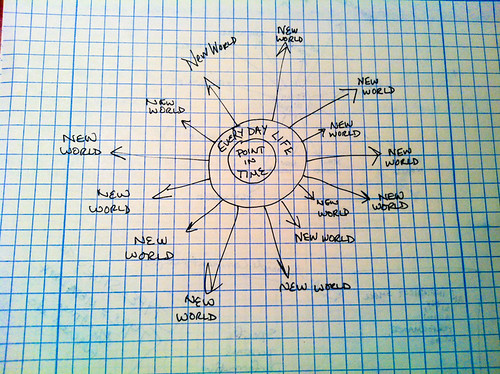Last week in Intro to Civic Media we addressed political economy and propaganda in relation to the media. We began with Marxist and post-Marxist ideas of “base” (those people and things that gird the system in the form of physical labor and natural resources) and “superstructure” (those people and things responsible for the reproduction of the ideology of the system).
We discussed some of the drawbacks of a strictly Marxist interpretation of political economy (for example, the categories of base and superstructure being too binary and rigid) as detailed by Nicholas Garnham. We also reviewed an article by Paula Chakravartty that takes a bird’s eye view of globalization and communications and dissects power and resistance with post-colonial models grounded in specific examples that include many non-Western geographies. These forays, combined with our discussion of propaganda, make it crystal clear that whether or not we agree about bases and superstructures there are large structural forces at play that shape media and culture.
But, to pick up on our Marxist thread and the way we ended class with a Theory of Change workshop, the question then comes back an old one proposed by Lenin – What is to be done?
And, in particular, what is to be done in the everyday? What is to be done in the city? What is to be done in the community? What is to be done in the home? What is to be done within one’s sphere of influence which is, for most of us, small and local but not insignificant?
In his book the Practice of Everyday Life, Michel De Certeau details how everyday activities such as reading, walking, and cooking, might in fact be construed as radical tactics. Not because people are walking for peace or cooking for policy. But because these actions of one’s everyday existence are in fact creative and transformative. They bring new things – thoughts, sweet potato pie, footprints, CO2 – into the world. This is already change and we should begin by acknowledging the radical potential of everyday life.
Because when do we know that something begins? And how do we know that something has happened and that we are qualitatively different as a result? We are always different and differing, our bodies are living and dying ecosystems, we are endlessly creative (even when not trying to be artists) and causation is one of the strangest things around.
I don’t mean to remove this conversation from the political but rather to ground the political in the potentiality of everyday life – this here and now – the one where I’m sitting on a carpet awash in tumbleweeds of cat fur typing a blog post while my kids sleep. Starting in the belly as it were, which is, incidentally, helping to keep me upright (thanks, belly). And it’s not just personal although I agree that the personal is political and I owe feminism lots of things including my desire to remain at my own scale most of the time.
Scale is really the main question here. A theory of infinitely small change takes its sphere of operation as the little, local, personal, fluid, fleshy, experiential. Couldn’t something immense happen from reading a single word, disagreeing silently, shaking someone’s hand, feeling the air move differently when doors are open, or perhaps from noticing nothing consciously but just feeling different? What would the threshold be where you would say “Something has happened”? And from there, the infinitely small might even just be right under that. The key is to begin a beginning and experiment with deploying beginnings. Beginnings sometimes go somewhere but most of the time they just trickle away, kind of as if nothing had happened. And that’s ok too – to let beginnings be bygones.
Using Civic Media to effect infinitely small change would mean foregrounding encounter, experience and emotion in specific situations for specific audiences. It would mean addressing people as not just heads but also bodies. It would allow lots of room for failure but “nothing happened” might not be failure and “reaching only a couple people” might also not be failure. Maybe the only real failure would be about not allowing enough space, silence, listening, and participation for infinitely small change to actually occur.
All of this is not say we should privilege everyday life above and beyond larger scale theories of social change (or walking and cooking over more recognizable and collective forms of political action) but only that we should perhaps consider including the specifically personal, mundane, emotional and experiential into any theory of change because it is this connective tissue – the capacity for love and empathy – that binds us together in the first place. And the only way we’ll get anywhere is if we go together.


